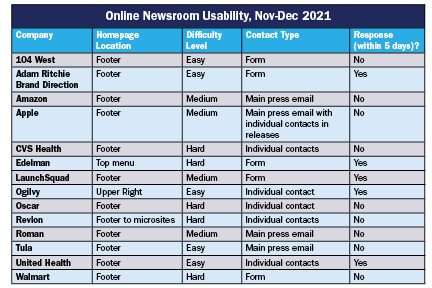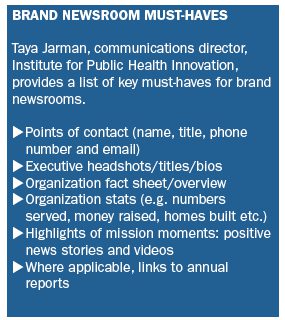
Few things are more frustrating to reporters on deadline than a fruitless search for basic company information or a media contact. Another 'favorite' of journalists: Heading to a brand newsroom, filling out and submitting a 'Contact Us' or query form and receiving no response. It's as if the form disappeared into the ether. Sometimes the result is that the planned story, which possibly was favorable to your company, also disappears.
Surely that's no way to run a railroad or a brand newsroom.
To make sense of this we did some secret window shopping this past holiday season. Our goal was to survey the efficiency of company and PR agency brand newsrooms and sites.
For our experiment, we completed contact forms and emailed media contacts listed on sites in November and December 2021. When an online form requested a topic, we were transparent. We responded that our inquiry was for a PRNEWS story examining best practices for brand newsrooms.
While we looked at just 14 sites, our informal survey offers a view into how several Fortune 10 brands and a couple of smaller companies—as well as a few PR agencies (large and boutique)—handle media inquiries.
In short, we found a mixed bag. Some sites were easy to navigate, making the journalist's life simpler. On the other hand, while several brand newsrooms responded to our query promptly, others left us in the cold.
After a summary of our shopping trip, we have several PR pros offer ideas to close holes in brand newsrooms. In addition, a few argue against online brand newsrooms and some suggest new-fangled arrangements.
Secret Shopping Criteria
The common denominator across most of the brand newsrooms we 'shopped' is an 'About Us' or 'Contact Us' link in the homepage footer. Typically these lead to a press center or newsroom, with a varied number of intermittent sites.
In the table below, Difficulty Level refers to how easy or hard it was to reach the press contact or newsroom site from the homepage (i.e., the amount of scrolling or clicking through required).
The number of press contacts available and whether a site had a general press email or a specific PR pro listed varied. Sometimes contacts were listed on the website; other times they were included at the bottom of a PDF press release.
Clicking through multiple sites to find the press page or downloading a PDF to locate a media contact introduced unnecessary friction into the process. It's likely this will trigger in a journalist the desire to look elsewhere for a source.
Fortunately, the PR agencies we examined usually made themselves available via a 'Contact Us' form. Again, there were variations in whether they located the form front and center or it required digging to find. The more digging, the greater our interest waned in extracting a quote from the source.
As research shows, time is precious to journalists. As such, we also considered brand newsrooms' response times. Arbitrarily, we set five business days as the limit for an organization to respond after a Contact Us form was submitted via its site. Some journalists have five days to wait for a response; others don't. As you can see from the table, just more than one-third of organizations responded within 5 days. This feeds journalists' perception that filling out a Contact Us form on brand sites is a fool's errand.
Moreover, it's helpful to receive an estimate of response time, so we knew whether to look elsewhere. It stands to reason that the quicker the response, the more likely a journalist will reach out to the source for a future story.
Also arbitrarily, we counted a response as a Yes if we received an email or phone call within the 5-day window, whether or not a source ultimately was made available for comment. We appreciated the human element of an emailed response, even if the response was simply: Unfortunately, our representative is unavailable.
 Source: PRNEWS research, January 2022
Source: PRNEWS research, January 2022
Newsrooms Must be Crisis-Ready
In addition to our informal survey, we asked PR pros to share their brand newsroom best practices.
Leveraging her background in the public sector, Taya Jarman, communications director at the Institute for Public Health Innovation, considers crisis planning when thinking of brand newsrooms.
“In the event of a crisis, the media member should not have to complete a form,” she argues. “Even if your organization is small, there should be some direct point of access for questioning and further information.”
Jarman adds that organization newsrooms should be clearly listed in a website header or footer. She also provides a checklist for PR pros to use for newsroom layout (see below).
A Meta-Newsroom?
Some media assets live primarily on social media–think the hip app companies with minimalist websites or Linktree users. However, Alan Marcus, VP, LaunchSquad, says it’s still a good idea for these “growth-stage” companies to maintain a basic online newsroom.
“In most cases, brands have all of the necessary materials–recent news, press releases, logos, executive bios—and just need to house them together under one roof,” he argues.
Similarly, Sarah Evans, founder and CEO of Sevans Strategy, argues that every organization needs a newsroom, although it need not live on a company website. Working frequently with tech startups, Evans says her team is exploring the concept of a metaverse press room.
For example, PR pros can shake up things by housing newsroom elements (or perhaps virtual press conferences) in a virtual office setting like SoWork, she says. This allows companies to craft sprawling campuses reminiscent of 90s and early aughts video games.
For the right brand, it could work: Imagine virtually strolling through a company HQ, finding a number of materials on a virtual desk or hanging neatly on an office wall, and interacting with items to bring forth videos, photos and press releases. Software like SoWork also allows video calls; perhaps virtual press conferences could be worked into such an arrangement.
The Invisible Beauty of a Press Kit
While Adam Ritchie Brand Direction principal Adam Ritchie eschews the idea that every brand needs a newsroom, he argues all should have a press kit. A press kit, he says, is invisible to the public, and is subject to the PR team’s decision to send, proactively or reactively.
“A kit is more useful to the media and easier to maintain for the PR team,” Ritchie adds.
Evans’ team favors story-specific downloadable folders for journalists to easily access images, press release PDFs and Word docs. The media contacts she works with are not fans of massive email attachments, she says.
Controlling the Assets
Ritchie doesn’t like the “passive” element of digital newsrooms, believing them to be limiting. He argues that digital newsrooms can serve as “an all-you-can-eat buffet of information and assets, which opens the door to anyone covering the brand, however and whenever they'd like.”
Instead, Ritchie’s approach is PR-empowering.
“Make [reporters] go through you," he argues. "Don't give up your ability to shape and influence the coverage.” This entails playing a little harder to get with press assets and forcing journalists to go through “appropriate media channels, which you get to choose.”
Ritchie says this allows PR pros to find angles different from the reporter’s initial line of inquiry. Of course, these angles must please the company and the journalist.
Integrating Social
Like Evans and Ritchie, Katie Walmsley, president, BlueRoom Studios, part of Edelman Studios, takes a less website-dependent approach. She asserts that newsrooms in 2022 should all have social media distribution baked in. What was once simply a home for press releases now represents something larger: “How you or your clients show up across the digital ecosystem every day as a brand.”
Walmsley encourages communicators to consider that their initial newsroom concept may shift. Marcus sees social media as more of a “helpful supplement,” while still finding “a simple, easy-to-find newsroom on the corporate website” useful.
Tried and True
Evans’ checklist for online pressrooms closely resembles Jarman’s.
“At a minimum, you should have key assets in place, [including] recent press releases, hi-res [media] images and hi-res founder and leadership headshots.” Evans adds that the most important links should be clustered in an easy-to-find location, and suggests including corporate FAQs. Company logos in multiple formats is an asset Marcus considers important.
‘Don’t Make it a Guessing Game’
When it comes to naming and locating a newsroom on your website, “don’t overthink it and don’t try and be clever; be practical,” Marcus advises. As an SEO best practice, list the page as a brand newsroom or simply newsroom, so it comes up right away in searches.
“Whether it’s at the top of the site, a footer or a separate landing page altogether, be sure to give it a clear label,” Marcus says. “Don’t make it a guessing game—make it easy!”
General vs. Individual Contacts
On the subject of contacts, Evans prefers a general press email. She says “dividing up appropriate contacts is important,” but notes that using one email can “always get people to the right place.” This assumes PR pros on the other end quickly select the appropriate spokesperson for a story.
Of course, Evans' suggestion also assumes staff check email frequently.
In our informal survey, however, none of the four brand newsroom sites that used general press emails yielded a reply.
When issuing press releases, companies should include contact information for the person managing the brand, story or announcement, Evans says.
Ritchie argues for putting the press contact next to the general contact form or email on a brand website.
“Reporters under the pressure of a deadline don't have time to chase a press contact email down the rabbit hole of an online pressroom. They'll run a Google search, look for the word ‘contact’ on a company's website and fire off an email to the first address they find,” he says.
While that approach might flood the PR team’s inbox with customer complaints, “catching one NY Times inquiry on deadline is worth 100 misfired consumer emails.” Plus, giving PR visibility into customer complaints is a great crisis-prep tactic, Ritchie adds.
Go Easy on Journos
Marcus agrees that it’s crucial to peruse your newsroom through the eyes of a journalist with a tight schedule. For instance, a reporter with a looming deadline might not reach out to the press team, instead visiting your website for quick source materials.
“If there’s nothing there or the materials are outdated, it could ultimately be detrimental to the story and frame your brand in a poor light,” he warns. (Hence our dismay when it appeared that some general press emails listed turned out to be out of date. In other words, the press contact listed is no longer employed at the company.)
Marcus has reasonable criteria for judging whether a newsroom is complete or missing crucial pieces. Too often, he says he encounters newsrooms that include press releases but lack hi-res images, or that offer numerous downloadable logos without fresh news items.
On the other hand, creating a news release just to keep your site fresh isn't a good tactic. Better for you to make clear that your site was updated recently.
Whatever formats, links or contact information your organization decides to prioritize in its newsroom, Marcus reminds communicators, “Going the extra mile to make newsrooms as complete as possible will ultimately make journalists’ jobs easier and save them time so they can spend more time focusing on what’s most important: the story.”

